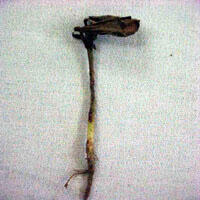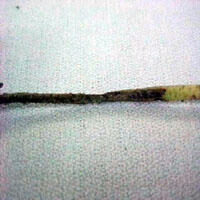Cotton
Sand Blasting Injury
Sand blasting is generally not a wide spread problem for us. However, some problems do occur to some degree each year. Blowing sand can open wounds in the plant tissue which allows pathogens access. Wind driven soil particles may even carry herbicide residue directly into the plant tissue. The additive effects of these injuries can be detrimental to cotton seedlings.

As the symptoms get worse, stems will show signs of splitting, cracking, necrosis of tissue and develop a dark brown to black color. Leaves will especially develop a black appearance. This discoloration will generally develop within a day of the wind storm event. Sometimes the symptoms start out very mild and progressively get worse. This is especially true if windy conditions persist for several days.
As fields are evaluated for damage there are several things to look for and consider. First take note of your growing area and the calendar date. Next take note of the soil productivity and whether the field is irrigated or not. Calendar date and soil productivity must be considered and will aid in deciding whether or not to keep the stand, replant to cotton or to replant to an alternative crop. Also growers should have an in-depth knowledge of his insurance coverage and provisions.

If the wound has penetrated the cuticle and not damaged the stele, the stem will most likely form callus tissue and scar over the wound. If the wound extends into the stele, it is likely that the stem will break before the plant can recover. In making stand counts, only count plants that have superficial and recoverable damage to the stem.
Damage to the leaves may range from slight abrasion of the cuticle to complete desiccation. Loss of the waxy cuticle from the cotyledon and true leaves will hasten water loss contributing to desiccation. If leaf burn and desiccation is a problem, examine the last expanding true leaf and the tissue in the terminal. If the last expanding true leaf only has mild damage and the tissue in the terminal is still green, the plant will most likely recover. That is of course if the stem is still viable.

In fields where blowing sand is a perennial problem, corrective (preventative) measures can be taken. The picture representing planting cotton notill into a cover crop is one of the best fixes going. There are several ways to accomplish this. In the fall, row the field up and fly (broadcast) wheat into the field (keep seeding rates low, in the 40 to 60 pound range as you are not planting for grain nor for grazing). Then, the field may be either rehipped or you may wish to drag the rows somewhat flat. If the field is rehipped in the fall, it may need dragging down a little in the spring which may reduce some of the effectiveness of the what as a wind break, but it will still be much better than nothing. In the spring, let the wheat grow tall and head out before it is burned down. Burn the wheat down about two weeks ahead of planting. At planting you may need additional burn down but make that decision on the spot. As the field is planted the use of a systemic insecticide for thrip control is recommended and cutworm control is also recommended. After the cotton is planted the use of a hooded sprayer, over the top sprays or lay-by rigs are recommended rather than cultivation. Cultivation will destroy the benefits of the wheat as a wind break. Those who have not tried this will be very pleasingly surprised at the effectiveness of such treatments.
Boll weevil eradication, Bt cotton and new chemistries on the market today make this decision easier than in the past.
Cotton
- Application timing
- Boron Deficiency
- Bronze Wilt
- Can you tell me about sprayer calibration?
- Commonly used harvest-aid materials
- Defoliation General Discussion
- Hail Damage
- Nitrogen
- Nitrogen Deficiency
- PIX Use
- Potassium
- Potassium Deficiency
- Potassium Sources
- Questions about cotton following a hurricane
- Sand Blasting Injury
- Sulphur Deficiency
- What are Mississippi's freeze dates?
- What final live plant population should I target?
- What is the recommended seeding rate for cotton?
- What percentage of my crop should I plant in B.t.?
- What should be the soil temperature at planting time?
- What should I do about hail damaged cotton stands?
- What variety, or varieties, should I plant?
- When should I consider replanting cotton?
- Will foliar feeding seedling cotton increase yield?